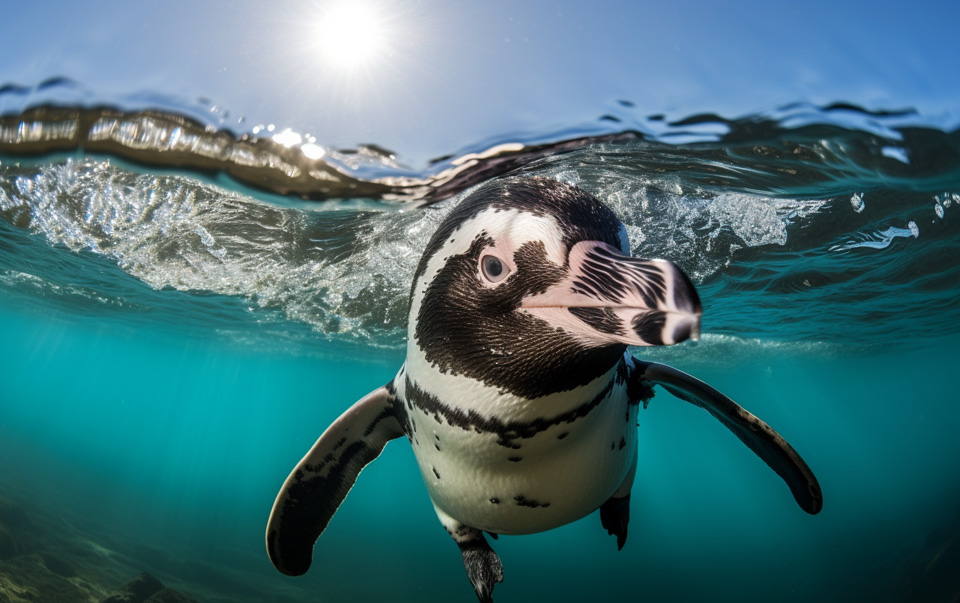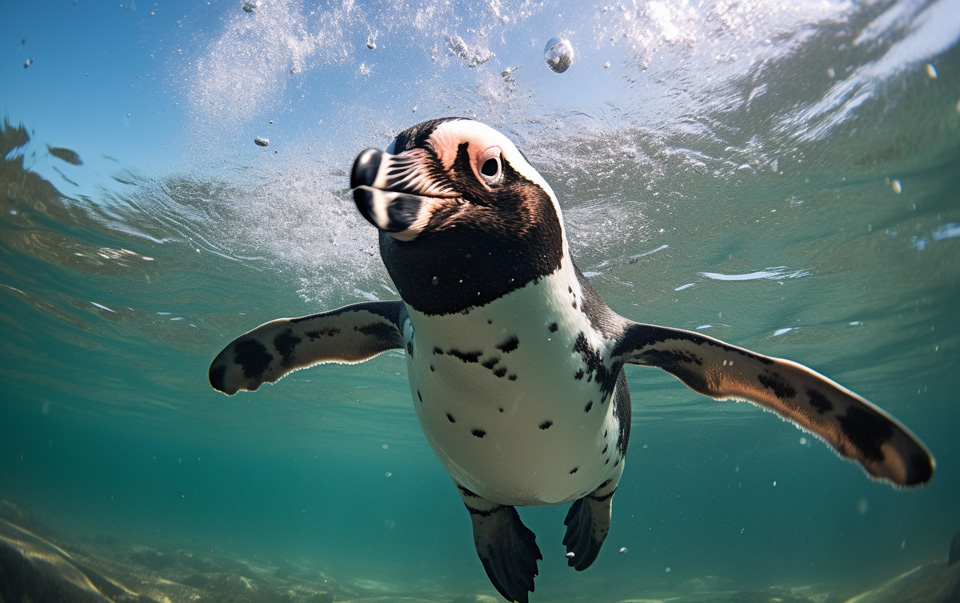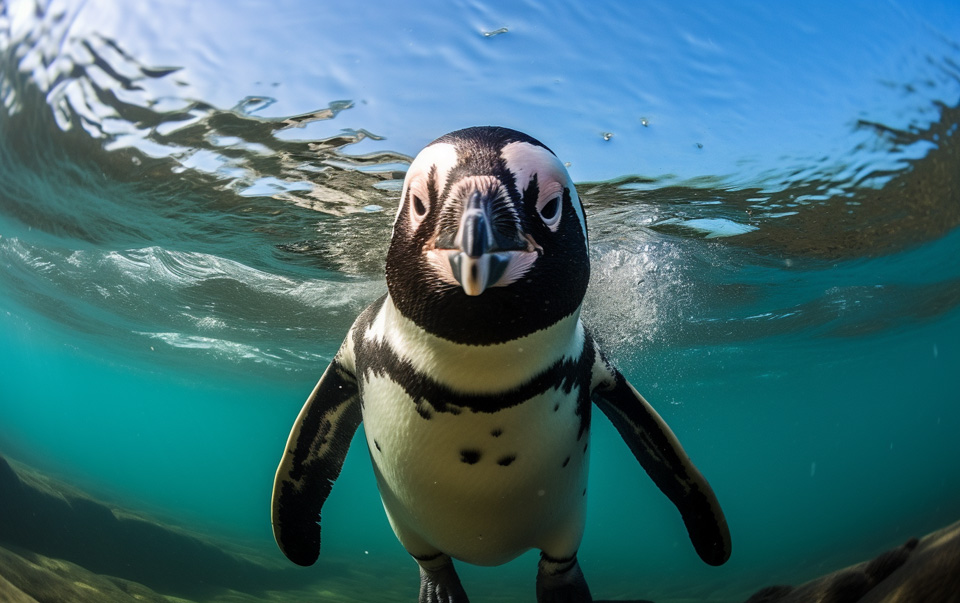Penguins, with their incredible swimming and diving skills, can explore impressive depths in search of food. Different species of penguins have varying diving capabilities.
The emperor penguin, the largest species, can dive to depths of over 550 meters (1800 feet), while the Adelie and King’s penguins can reach depths of around 300 meters (980 feet). Gentoo and chinstrap penguins typically dive to depths of approximately 60 to 120 meters (200 to 400 feet). The African penguin can dive up to depths of 18-24 meters (60-80 feet) while foraging for food. These beautiful birds have adapted to their marine environment and are adept at diving and hunting underwater.
Key Takeaways:
- Penguins have impressive diving capabilities with species reaching depths of over 550 meters (1800 feet).
- Emperor penguins are the deepest divers among penguins.
- Adelie and King’s penguins can dive to depths of around 300 meters (980 feet).
- Gentoo and chinstrap penguins typically dive to depths of approximately 60 to 120 meters (200 to 400 feet).
- The African penguin can dive up to depths of 18-24 meters (60-80 feet) while foraging for food.
- Penguins use their diving skills to search for food underwater.
Adaptations for Deep Diving

Penguins have fascinating adaptations that allow them to thrive in the depths of the ocean. These adaptations have evolved over time to help them withstand the challenges of deep diving and ensure their survival in the underwater environment.
One of the key adaptations is their waterproof feathers, which play a crucial role in insulating their bodies and reducing drag when swimming underwater.
These feathers are tightly packed and coated with a special oil that repels water, keeping the penguins warm and allowing them to move through the water with ease.
Another important adaptation is their dense bones, which help them sink effortlessly to great depths. The increased density of their bones enables penguins to dive deeper, as they are less buoyant and can reach their desired depths quickly and efficiently.
In addition to their feathers and bones, penguins have other physical adaptations that aid in their deep diving abilities. Their paddle-like flippers provide powerful propulsion, allowing them to swim at high speeds and maneuver effectively in the water.
The wedge-shaped tail further enhances their agility and maneuverability, enabling them to navigate through complex underwater environments.
“Penguins have fascinating adaptations that allow them to thrive in the depths of the ocean.”
Regulation of Heart Rate and Blood Flow
Alongside their physical adaptations, penguins possess remarkable physiological adaptations that enable them to regulate their heart rate and blood flow while diving.
This helps them conserve energy and oxygen during extended periods underwater. By slowing down their heart rate and redistributing blood flow to vital organs, penguins can sustain their dives for longer durations, allowing them to search for food and explore their underwater habitats.
Furthermore, penguins have developed specialized salt glands located near their eyes, which help remove excess salt from their bodies. This adaptation is crucial for maintaining the balance of salt and water levels in their system while diving in saltwater environments.
Overall, the adaptations of penguins for deep diving are truly remarkable. Their waterproof feathers, dense bones, flippers, tail, and physiological adaptations all work together to create the perfect combination for underwater survival and successful hunting.
Diving Depths of Different Penguin Species

As we’ve mentioned earlier, penguin species have varying diving capabilities. Let’s take a closer look at the diving depths of some popular penguin species:
Emperor Penguin
The emperor penguin is the deepest diver among all penguins, capable of reaching remarkable depths of over 550 meters (1800 feet). These majestic birds can venture into the depths of the ocean to search for their preferred prey.
King Penguin
The king penguin, another impressive species, can dive to depths of around 300 meters (980 feet). These regal creatures are well-adapted to deep dives, allowing them to explore the underwater world in search of food.
Little Penguin
On the smaller end of the spectrum, the little penguin typically dives to depths of around 20 meters (65 feet). Despite their diminutive size, these energetic penguins are still capable of navigating the waters to find their meals.
Humboldt Penguin
Humboldt penguins, native to the coasts of South America, have a diving range of approximately 60 to 120 meters (200 to 400 feet). These charismatic birds are known for their agility underwater and can dive to considerable depths.
African Penguin
The African penguin, found along the southwestern coast of Africa, can dive up to depths of 18-24 meters (60-80 feet) while foraging for food. These beautiful birds have adapted to their marine environment and are adept at diving and hunting underwater.
Each penguin species has its unique diving capabilities, enabling them to explore the depths of the ocean in search of food. Their impressive dive depths showcase their remarkable adaptations to marine life and highlight their extraordinary swimming skills.
Diving Techniques and Behaviors
Penguins have developed impressive diving techniques and exhibit fascinating behaviors to explore the underwater world in search of food. Let’s take a closer look at how these remarkable creatures dive and navigate their way through the depths.
When penguins dive, they start by propelling themselves into the water, using their flippers and tails to accelerate their descent. Their streamlined bodies and hydrodynamic shapes help reduce drag, allowing them to move quickly and efficiently underwater.
Penguins have evolved to be expert swimmers, using their webbed feet for steering and propulsion.
Once they reach their desired depth, penguins display incredible hunting skills. They use their specialized muscles to maneuver and chase after their prey with precision.
Penguins can adjust their movements to navigate through different underwater environments, making them highly adaptable hunters.
Diving Process
During a dive, penguins regulate their buoyancy by adjusting the amount of air in their air sacs. This enables them to control their depth and stay submerged for extended periods.
Penguins have excellent control over their swimming speed and direction, allowing them to navigate efficiently in search of food. When they’ve finished hunting and it’s time to resurface, penguins swim upwards and break the water’s surface headfirst.
Overall, penguins demonstrate incredible diving techniques and behaviors that have enabled them to thrive in their aquatic habitats. They use their flippers, tails, and specialized muscles to move with agility and precision underwater.
These adaptations, coupled with their ability to regulate their buoyancy, make penguins exceptional divers.
Safety and Adaptations for Deep Diving
Penguins have developed remarkable adaptations and behaviors to ensure their safety during deep diving expeditions. These adaptations allow them to avoid potential risks associated with the extreme depths they reach in search of food.
One of the significant risks penguins face during deep dives is decompression sickness, commonly known as “the bends.” However, penguins have a unique mechanism that helps them gradually adjust their bodies to changing pressure, minimizing the risk of this condition.
This adaptation reduces the formation of harmful bubbles, allowing penguins to safely ascend to the surface without experiencing any adverse effects.
Penguins also possess efficient oxygen storage systems and high metabolisms, enabling them to remain underwater for extended periods. This adaptation ensures they have an adequate oxygen supply throughout their deep diving ventures.
By efficiently utilizing their oxygen, penguins can safely explore the depths and ascend to the surface without any complications.
Additionally, penguins’ adaptability extends to their ability to control the amount of nitrogen in their bodies. This mechanism helps prevent the formation of nitrogen bubbles, further minimizing the potential risks associated with deep diving.
These adaptations, combined with their natural instincts and behaviors, allow penguins to dive safely and thrive in their oceanic habitats.
Conclusion
Penguins are truly extraordinary creatures, perfectly adapted to thrive in the depths of the ocean. Their diving abilities are nothing short of impressive, with some species reaching depths of over 550 meters (1800 feet).
These remarkable birds have developed a range of adaptations that enable them to explore the underwater world with ease.
With their waterproof feathers, dense bones, and specialized flippers, penguins have the necessary tools to navigate the challenges of deep diving.
They can control their buoyancy, swim at high speeds, and effortlessly maneuver through their underwater environment. These incredible adaptations make penguins highly efficient hunters, allowing them to search for food and survive in their aquatic habitat.
In summary, penguins are true champions of the deep. Their remarkable diving depths showcase their resilience and adaptability.
Whether it’s the Emperor penguin diving to incredible depths or the little penguin gracefully exploring shallower waters, these creatures never cease to amaze us.
As we marvel at their capabilities, let us also remember the importance of respecting their natural habitats and approaching any interactions with these remarkable birds ethically and responsibly.
FAQ
How deep can penguins dive?
Penguins can reach impressive depths in search of food. Different species have varying diving capabilities, with emperor penguins being the deepest divers at over 550 meters (1800 feet).
What adaptations do penguins have for deep diving?
Penguins have several adaptations that enable them to survive and thrive underwater. These include waterproof feathers, dense bones, paddle-like flippers, a wedge-shaped tail, webbed feet, and salt glands to remove excess salt from their bodies.
How deep can different penguin species dive?
Emperor penguins can dive to depths of over 550 meters (1800 feet), king penguins can dive to depths of around 300 meters (980 feet), and little penguins typically dive to depths of around 20 meters (65 feet).
How do penguins dive?
Penguins dive by jumping into the water and swimming down to their desired depth. They use their flippers and tails to propel themselves and control their movements underwater.
What safety precautions do penguins have for deep diving?
Penguins have adaptations and behaviors that help them avoid risks associated with deep diving. They can control their buoyancy, regulate their blood nitrogen levels, and have efficient oxygen storage systems and high metabolism.
Can I scuba dive with penguins?
While it is possible to scuba dive with penguins in certain locations, it is important to approach these interactions ethically and responsibly to avoid disturbing their natural habitats.

